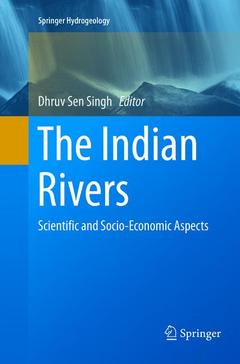The Indian Rivers, 1st ed. 2018 Scientific and Socio-economic Aspects Springer Hydrogeology Series
Coordonnateur : Singh Dhruv Sen

The book presents geomorphological studies of the major river basins ? the Indus, Ganga and Brahmaputra and their tributaries. Besides major basins, the book explores peninsular rivers and other rivers state-by-state. All types of rivers, i.e. snow-fed, rain-fed and groundwater-fed rivers are explained together in geological framework.
Rivers are lifeline and understanding of the rivers, their dynamics, science and socio-economic aspect is very important. However, different sources provide different data base for rivers. But a book which explains all major rivers of a country at a single place was not yet available. This book is the first book of its kind in the world which provides expert opinion on all major rivers of a country like India. This book complements works in these areas for the last two to three decades on major rivers of India by eminent professors and scientists from different universities, IITs and Indian research institutions.The information presented in the book would appeal to a wider readership from students, teachers to researchers and planners engaged in developmental work and also to common people of the society concerned with awareness about rivers.
Presents the geomorphological and socio-economic aspects of the major rivers of India
Includes chapters written by experts working on Indian rivers
Updates readers involved in teaching, research and planning the developmental work
Includes supplementary material: sn.pub/extras
Date de parution : 06-2019
Ouvrage de 551 p.
15.5x23.5 cm
Date de parution : 01-2018
Ouvrage de 551 p.
15.5x23.5 cm



